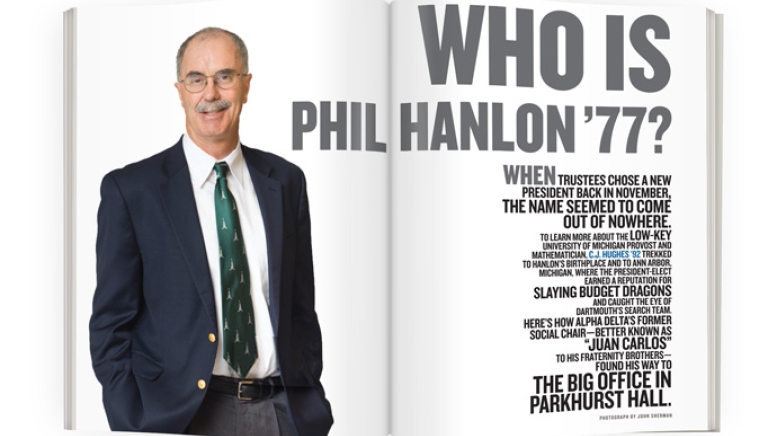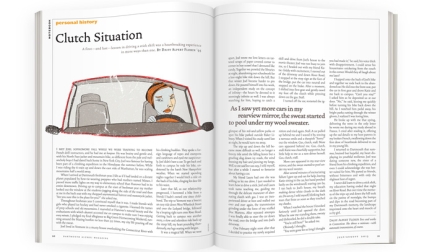Phil Hanlon answers the door wearing flip-flops.
It’s not the oddest choice of footwear given it’s 7:45 in the morning and he’s at home near the University of Michigan, where he serves as the provost, but the sandals are paired on this February weekday in Ann Arbor with a light blue tie, checkered Oxford shirt and dark dress pants—a work outfit.
Conventional shoes will be slipped on before Hanlon, 58, leaves his modest colonial-style home to head to his office, where he’s been fine-tuning budgets and getting ready to decide who gets tenure before packing up to become the 18th president of Dartmouth. For the moment, though, the combo of Ivy prep and pool casual seems the essence of Hanlon’s contrasts: buttoned-up and laid-back, intellectual and aw-shucks, a guy just as comfortable in burger joints as in a discussion about quadratic ring-class groups, his math Ph.D. subject.
It’s little surprise that when his chocolate Lab, Mocha, starts barking in the kitchen, threatening to cause a disruption, Hanlon sits tranquilly, almost Zen-like in his calm. “It’s been like a dream come true,” he says, while picking at a scone, of being selected to lead his alma mater. “And I think it will be really fun.”
When Hanlon first showed up in Hanover in the fall of 1973 from the tiny, almost-in-Canada town of Gouverneur, New York, (population 3,900) he didn’t have a clue about a career, let alone his major. In a way, it’s surprising he didn’t wind up as the head of a hospital or in the medical field. His father, George Hanlon, was one of seven sons of an Irish immigrant doctor in Hazleton, Pennsylvania, to go to medical school and one of six to go into practice. Phil’s mother, Peggy, a former Kansas schoolteacher, worked for the Red Cross in New Guinea and the Philippines in World War II, during which she survived a bout with dysentery and a major plane crash, according to acquaintances and family.
After three years in the Army George Hanlon began training to be a surgeon at the famous Mayo Clinic in Rochester, Minnesota, but Edward J. Noble, a Gouverneur native best known for owning the Life Savers company, had other plans for him. (An oversized “Pep-O-Mint” roll stands near the main intersection of Gouverneur today.) Noble was funding a new hospital in his hometown, which is in a rural area that relied on one-room schoolhouses into the 1950s. The town had its dangers as many locals worked in talc and zinc mines whose tunnels snaked three-quarters of a mile underground. Noble placed a call to Charles W. Mayo, the son of the clinic’s cofounder, who recommended Hanlon. He came right away.
“The Hanlons were very well liked by everyone,” says Bill Scozzafava, 86, a longtime Gouverneur resident and owner of Gouverneur Auto Parts & Supply. That fondness had a lot to do with the fact that Doc Hanlon seemed to take care of just about everybody in the course of a 35-year career—re-attaching thumbs, giving allergy shots and delivering babies, occasionally in the middle of the night.
Today Gouverneur, like Phil Hanlon, radiates a folksy charm. Among the 19th-century brick buildings along East Main Street is a diner called Jumbo’s, which serves slices of homemade pie at a counter with swiveling stools. A whiteboard menu reads “stressed spelled backwards is desserts.” Yet there are signs of economic struggles. That same strip of buildings has four vacancies, and a storefront church has taken over a former printing shop.
Kinney Drugs, a local chain, remains a big employer, and in the 1980s a prison went up in a pasture, but the town’s mainstays, two large mines, are basically mothballed. Their hulking facilities loom spectrally over pine trees today. Jumbo’s, which was open round-the-clock when there were three shifts at the mines, now shutters at night.
“People were upset by the mine closings because it leads to a downward spiral,” says Joe Laurenza, curator of the local museum, which has a rock-filled mine car on display in its basement. “People have less money to spend, local businesses close.”
When Hanlon was a kid, however, Gouverneur was in its prime, says Greg Petitto, a friend whose family owned the popular Roma Restaurant. “Friday nights were like New Year’s Eve, with people two or three deep at the bar waiting to get a seat,” Petitto says. “People here had lots of disposable income.”
With a doctor in the family, the Hanlons—George, Peggy, Phil and older brother Greg—were among the better off. The wood-paneled, four-bedroom ranch they built at the end of a cul-de-sac surrounded by trees was considered among one of the nicest homes in an area where aged Victorians ruled.
Growing up there was idyllic. The back yard hosted neighborhood football games. A barometer for do-it-yourself weather forecasting was inside. There was also much music, encouraged by his mom, says Hanlon, who sang and played the piano and trombone.
Greg, born in 1952, was the star in the Hanlon family, taking the lead vocal parts during Christmas sing-alongs on the family Steinway, winning local talent contests and starring as Patrick in a town production of Mame, according to friends and The Gouverneur Tribune-Press.
Phil, meanwhile, was more likely to be found in the home’s finished basement, which boasted an eight-foot pool table that doubled as a pingpong table. Down there Hanlon’s tight-knit crew—a group that was notably clean-cut amidst the sea of facial hair that appears in their 1973 yearbook—regularly played poker into the night. Three-card-stud for a penny a point was a favorite, says Jim Lallier, a friend who played with Hanlon on the golf team. Hanlon won frequently.
“You could always see a leadership ability in him then,” Lallier says. “He had a kind of plan going on inside, you could tell.”
Lallier skipped college and now works for a local Chrysler dealership. Other classmates took similar paths. Of the 187 seniors in Hanlon’s graduating class, just 77 went on to pursue higher education, according to the Tribune-Press. Of those, many attended two-year programs.
Though he may have been wealthier than his classmates, and angling to get out and move on, Hanlon never acted haughty, says Barry French, who taught him algebra and geometry in high school. “He always helped out the other kids,” says French, retired in South Carolina since 1997. “He was a good kid to have in class.”
But even when he was somewhat out of his element he could be competitive, says Greg Longevin, a friend from the varsity basketball team whom Hanlon was frequently assigned to guard in practice. “He would try his damndest to defend you, until you gave him a quick little zip and went in for a lay-up,” Longevin says, laughing. “He’d fall down, he’d get up, he’d have a smile on his face. I think that’s an attitude he carries with him.”
Despite his drive, Hanlon kept his college wish list brief. Besides Dartmouth, he applied to St. Lawrence University, in just-down-the-road Canton, New York, and Notre Dame, where an uncle had ties. But a visit to Hanover sealed the deal.
Hanlon says he had a hard time adjusting in college, in part because he had never been so challenged academically. His first year saw mostly Bs and Cs, he says. Don Pease’s English 5 class posed a particular challenge. The math bug bit him early on, spiking after an inspiring probability class with John Kemeny, who, as Hanlon says he will do, taught while he was president.
Refocused, Hanlon earned straight As for the next three years, which earned him a Phi Beta Kappa key. His calling became evident early. “Some of the professors thought of him more as one of them than a student,” says Frank Ittner ’77, a fellow Alpha Delta brother and now a business executive in Atlanta. Hanlon was looser in AD, where he lived for several semesters and served as social chair. “He was very quiet but extremely funny, with a sense of humor that could catch you off guard,” Ittner says.
Nicknamed “Juan Carlos” for the mustache he began to sport that looked like that of the newly crowned King of Spain, Hanlon liked to collect paintings he picked up at garage sales that he gave fancy titles. One that showed animals playing poker, for instance, was rechristened, The Dogs: Ancient Persian Tapestry, says George Bullerjahn ’77, who was also in AD and is now a professor of biology at Bowling Green University.
Both Democrats, Bullerjahn and Hanlon remained fairly apolitical, even as the country was roiled by the aftermath of Watergate and the Vietnam War, Bullerjahn says. They also welcomed the arrival of women to campus as some upperclassmen were vociferously opposing coeducation, he adds, but few brothers, including Hanlon, had girlfriends.
Hanlon did break with the pack when it came to music, preferring big-band and other untrendy genres over rock ’n’ roll. “I think that was mostly to amuse people,” says Bullerjahn. For a spring weekend party Hanlon skipped the usual local male-fronted ensembles and booked an all-female group out of Boston called Witch, which took the stage in head-to-toe black. “We all wondered, ‘Where did he find them?’ ” Ittner says. “I don’t think we ever found out.”
After graduation, as many classmates decamped for offices, Hanlon entered the California Institute of Technology. There he would earn his Ph.D., in 1981, and launch an impressive academic career, even if not everybody really “got” it.
One night, on a trip back to Gouverneur, Hanlon found himself at the Roma Restaurant, sipping Molson Golden Ales with Petitto. “I said, ‘Phil, just be straight with me. What the hell do you do? And keep it simple, because I’m a lowly restaurant guy,’ ” Petitto recalls. “Phil paused and then said, ‘Well, let’s just say I’m trying to figure things out.’ And we started laughing.”
In the fall of 1981 Hanlon began teaching applied math at the Massachusetts Institute of Technology and hanging out at a house in the Brighton section of Boston where some ADs lived.
One afternoon Bill Gentes ’77, one of those housemates, now an executive with Lane Press in Burlington, Vermont [DAM’s printer], invited Hanlon to play golf with him and his father, although they needed a fourth. Gentes suggested his older sister Gail, who had been overseas for a few years with the Peace Corps in Herat, Afghanistan, and was studying for an M.B.A. at Boston University.
The 18-hole blind date left Hanlon smitten, he says, and he and Gail were married two years later. Some rougher-around-the-edges AD brothers might not have gotten Bill Gentes’ seal of approval, Hanlon’s brother-in-law admits, but Hanlon is “the smartest guy I know, and I’ve been saying that for 40 years,” he says.
After marrying, Hanlon left MIT for a teaching gig at Caltech, where he crossed paths with Patrick Morton, a graduate math student from Michigan doing postdoc work. Like a baseball scout after a spring training game, Morton excitedly returned to Ann Arbor with reports of a new whiz.
“They worked on some problems together,” says Don J. Lewis, who chaired Michigan’s math department at the time, “and Morton kept saying how bright he was.” Lewis offered him a job in 1986—including a promise of tenure—before Hanlon even stepped off the plane, and Hanlon accepted, turning down similar offers from Wisconsin and Minnesota, he says. As the years went by Hanlon became a recruiting tool himself, luring other specialists in the burgeoning algebraic combinatorics field to Michigan, Lewis says.
After becoming associate provost in 2004 Hanlon had far less time to teach, though he regularly took on a 30-student class of first-years for calculus, which required much back and forth with other teachers, most of them grad students. Hanlon “never held himself as aloof or above them,” Lewis says. “He collaborated with them.”
Lewis, who has mentored Hanlon in connection with his administrative duties, says Hanlon would likely have been chosen as president of Michigan had he stuck around.
While raising his academic profile at Michigan, Hanlon was also busy as a father of three. Michael, 28, was recruited for long-distance running at Colgate, later coached there and now works in ticket sales for Chicago’s pro soccer team, the Fire. Maureen, 25, graduated from the College of Wooster and lives in St. Louis, Missouri, where she works for College Bound, a group that assists low-income, at-risk students. Patrick, 21, lives in Ann Arbor, where he works at a branch of Jimmy John’s, a sandwich chain.
For all the joys his career and family have brought him, Hanlon has suffered blows. Although his father lived until 2009, to the age of 93, his mother died of cancer in 1981 at 65. His brother, Greg, who had moved to New York City in the 1970s with the dream of being an opera singer and worked in music management, died of AIDS-related complications in 1988 at 35. “That was tough, because it was an extended and really difficult illness,” Hanlon says.
How different Hanlon’s life in Hanover will be from that in Ann Arbor is anybody’s guess; he’s left behind a city of 115,000 for a place that’s a fraction of that size. And yet his Michigan neighborhood of low-slung, close-together homes has an unmistakably small-town vibe.
He and Gentes parked their Toyotas in their driveway and, on pick-up days, put their trash out on the curb like their neighbors, forming a neat blue line of cans down the street. On Halloween a scarecrow wearing a Dartmouth sweatshirt appeared on the Hanlons’ lawn to entertain trick-or-treaters. On holidays Hanlon tickled the Steinway for guests, just as his family had long ago.
True to his low-key persona, Hanlon mostly passed unnoticed across campus, unrecognized by the university’s 60,000 students though he was often out and about. A favorite restaurant was a student haunt, Casey’s Tavern, which serves hamburgers and hot dogs.
Last year he spent a Saturday night watching the film The Artist at the next-to-campus Michigan Theater, says Peter Shahin, an editor at The Michigan Daily who sat near him. Shahin says he wouldn’t have recognized Hanlon if he hadn’t covered him for the paper.
In a sports-obsessed school, Hanlon was also a regular presence at football, hockey and basketball games, sometimes in private administration suites but also in the stands.
Hanlon and Gentes, who served as director of research at Michigan’s Ross School of Business until leaving in May, enjoyed getting off-campus, too. Last summer they kayaked past glaciers in Alaska. They’re also co-owners with friends of a getaway house on a golf course near Traverse City, Michigan. Gentes says she hopes to find another vacation home like it, much closer to Dartmouth, soon. She also hopes to land work, perhaps focusing on Dartmouth’s relationship to the Upper Valley, as well as volunteering, she says.
Hanlon will likely be remembered by many at Michigan for keeping the university afloat as state funding dropped by more than half in a decade. “During his time here he was really challenged by the difficult budget situation, which will be the defining thing of his tenure, whether he wants it to be or not,” Shahin says. To achieve his goals Hanlon tried a soup-to-nuts approach, from consolidating building cooling systems to make them more efficient to finding sponsors for the school’s research—coupled with annual budget cuts of about 2 percent a year. All told, his moves saved $235 million in 10 years. “We cut the budget strategically, over the long term, by doing things that take time to develop,” Hanlon says. The university’s current operating budget is $3 billion.
Even critics of his administration have a hard time begrudging Hanlon personally. On the brisk afternoon of the day he welcomed a morning visitor to his home, about 20 members of the Graduate Employees Organization, a union that represents grad student teachers, staged a protest in the tiny lobby of the building that housed Hanlon’s third-floor office on campus.
The “grade-in” was designed to boost the union’s stature in advance of some key contract negotiations, organizers said. At stake were salaries, which had risen about 2 percent a year previously but were expected to be frozen once the teachers’ contract expired, according to Marc Ammerlaan, a course coordinator in the biology department who was there.
Hanlon, who did not see the grade-in but was aware it was taking place, had not been sitting at the bargaining table this go-around, but Ammerlaan was holding out hope that he would be fair behind the scenes, an impression he had of Hanlon from personal dealings. “I don’t expect him to lay down his cards when he’s got a strong hand,” he says. “But at least he hasn’t been contemptuous.” (The standoff has since been resolved: Both sides have agreed to a new contract. As expected, the teachers will get nothing in 2014 and smaller raises during the next five years.)
The high degree of sportsmanship Hanlon seems to bring to any task at hand might explain his appeal. Bullerjahn, the AD brother, says that in college Hanlon would often beat him at cards and pool, but it was rarely a demoralizing experience. “You never felt bad about losing against him, because he was so nice about it,” Bullerjahn says. “He’s the guy you want to win.”
C.J. Hughes, a New York City-based journalist, is a frequent contributor to DAM.




